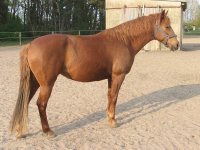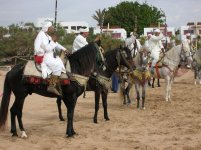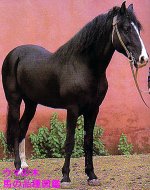♘امیرحسین♞
♘ مدیریت انجمن اسب ایران ♞
Developed on the Barbary Coast of North Africa, the Barb is a desert horse, with great hardiness and stamina. Due to the amount of cross-breeding, it is difficult to find a pure-bred Barb today. The horses generally possess a fiery temperament and an atypical sport-horse conformation, but nevertheless has had an incredible impact on today's modern breeds.
History of the Breed
It is not exactly known where the Barb developed, but the breed originated in Northern Africa during the 8th century, about the time that Islamic invaders reached the region. There is considerable controversy over whether the Barb and Arabian horses share a common ancestor or if the Arabian was a predecessor of the Barb. It is possible that a native horse of the region was influenced by the crossing of multiple "oriental" breeds, including the Arabian horse, Turkmenian or Akhal-Teke, Caspian horse, with Iberian horses brought back from Europe by the Moorish invaders after they conquered southern Spain. Today there are several varieties of Barb, including the Algerina, Moroccan, and Tunisian.
When imported to Europe, they were sometimes mistaken for Arabians, even though they have distinctly different characteristics, in part because their handlers were northern African Muslims who spoke Arabic. The Godolphin Arabian, which was one of the foundation sires for the thoroughbred breed, may have been a Barb stallion, and is sometimes called the Godolphin Barb.[citation needed]
It is now bred primarily in Morocco, Algeria, Spain, and southern France, although, due to difficult economic times in its homeland, the number of pure-bred Barbs is decreasing. The World Organization of the Barb Horse, founded in Algeria in 1987, was formed to promote and preserve the breed. However, due to political situations, it is difficult to say how much of an increase in numbers or purity the breed will have.
Although it is unlikely that the breed's true origins will ever be revealed, what is certain is that the Barb has had more influence on the development of equine breeds throughout the world than any other horse except the Arab. As with the Arabian Horse, it was the spread of Islam which led to the forerunners of today's Barbs reaching Europe from the early eighth century onwards (the first Muslim army, seven thousand strong, landed in Spain in spring of 711. Once established on the Iberian peninsula the Barb horse played a major role in the development of the the Andalusian (as well as the Lusitano), which subsequently became one of the major influences in horse breeding all over the world. Among the many historical references to "Barbary" horses perhaps the most famous in Roan Barbary, belonging to King Richard II of England. During the sixteenth century Henry VIII imported a number of Barbary horses into England and a century later the Barb played an important part in the evolution of the Thoroughbred. Elsewhere the influence of the Barb is still evident in the Argentinian Criollo and many American breeds including the American Quarter Horse, the Mustang, and the Appaloosa.
Despite its importance as a progenitor of other breeds, the Barb has achieved less widespead renown than the Arab, no doubt because it lacks the Arabian Horse's unique visual appeal, being much less refined and generally less impressive in appearance. Nevertheless it has the same boundless stamina and endurance, the same ability to thrive on meagre rations, the same sure-footedness- and an impressive turn of speed over short distances.
Breed Characteristics
The Barb is a light riding horse with great stamina. It has a powerful front end, high withers, short back, a sloping, narrow croup, and carries its tail low. It is hardy, with clean legs, and small, round, sound hooves. It does not have particularly good gaits, but gallops like a sprinter, which has influenced the racing breeds such as the Thoroughbred, American Quarter Horse, and Standardbred. It usually is gray, but bay, black, chestnut, and brown horses are also found. The Barb stands 13.3-14.1 hands high.
The Abaco Barb can come in different colors than the usual Barb, including splash overo (a color which is rare in other horse breeds), pinto, roan, chestnut, black, and other colors.
Abaco Barb
The Abaco Barb is an endangered breed of the Spanish barb that resides on the Island of Abaco in the Bahamas. The Abaco Barb is supposed to have descended from horses which had been ship wrecked on the Island during the Spanish Colonization of the Americas.
Very few Abaco Barbs are still alive today. At time of writing only four exist in the world. One of the stallions remaining, Capella, was made into a Breyer Model Horse in 2005.
History of the Breed
It is not exactly known where the Barb developed, but the breed originated in Northern Africa during the 8th century, about the time that Islamic invaders reached the region. There is considerable controversy over whether the Barb and Arabian horses share a common ancestor or if the Arabian was a predecessor of the Barb. It is possible that a native horse of the region was influenced by the crossing of multiple "oriental" breeds, including the Arabian horse, Turkmenian or Akhal-Teke, Caspian horse, with Iberian horses brought back from Europe by the Moorish invaders after they conquered southern Spain. Today there are several varieties of Barb, including the Algerina, Moroccan, and Tunisian.
When imported to Europe, they were sometimes mistaken for Arabians, even though they have distinctly different characteristics, in part because their handlers were northern African Muslims who spoke Arabic. The Godolphin Arabian, which was one of the foundation sires for the thoroughbred breed, may have been a Barb stallion, and is sometimes called the Godolphin Barb.[citation needed]
It is now bred primarily in Morocco, Algeria, Spain, and southern France, although, due to difficult economic times in its homeland, the number of pure-bred Barbs is decreasing. The World Organization of the Barb Horse, founded in Algeria in 1987, was formed to promote and preserve the breed. However, due to political situations, it is difficult to say how much of an increase in numbers or purity the breed will have.
Although it is unlikely that the breed's true origins will ever be revealed, what is certain is that the Barb has had more influence on the development of equine breeds throughout the world than any other horse except the Arab. As with the Arabian Horse, it was the spread of Islam which led to the forerunners of today's Barbs reaching Europe from the early eighth century onwards (the first Muslim army, seven thousand strong, landed in Spain in spring of 711. Once established on the Iberian peninsula the Barb horse played a major role in the development of the the Andalusian (as well as the Lusitano), which subsequently became one of the major influences in horse breeding all over the world. Among the many historical references to "Barbary" horses perhaps the most famous in Roan Barbary, belonging to King Richard II of England. During the sixteenth century Henry VIII imported a number of Barbary horses into England and a century later the Barb played an important part in the evolution of the Thoroughbred. Elsewhere the influence of the Barb is still evident in the Argentinian Criollo and many American breeds including the American Quarter Horse, the Mustang, and the Appaloosa.
Despite its importance as a progenitor of other breeds, the Barb has achieved less widespead renown than the Arab, no doubt because it lacks the Arabian Horse's unique visual appeal, being much less refined and generally less impressive in appearance. Nevertheless it has the same boundless stamina and endurance, the same ability to thrive on meagre rations, the same sure-footedness- and an impressive turn of speed over short distances.
Breed Characteristics
The Barb is a light riding horse with great stamina. It has a powerful front end, high withers, short back, a sloping, narrow croup, and carries its tail low. It is hardy, with clean legs, and small, round, sound hooves. It does not have particularly good gaits, but gallops like a sprinter, which has influenced the racing breeds such as the Thoroughbred, American Quarter Horse, and Standardbred. It usually is gray, but bay, black, chestnut, and brown horses are also found. The Barb stands 13.3-14.1 hands high.
The Abaco Barb can come in different colors than the usual Barb, including splash overo (a color which is rare in other horse breeds), pinto, roan, chestnut, black, and other colors.
Abaco Barb
The Abaco Barb is an endangered breed of the Spanish barb that resides on the Island of Abaco in the Bahamas. The Abaco Barb is supposed to have descended from horses which had been ship wrecked on the Island during the Spanish Colonization of the Americas.
Very few Abaco Barbs are still alive today. At time of writing only four exist in the world. One of the stallions remaining, Capella, was made into a Breyer Model Horse in 2005.




